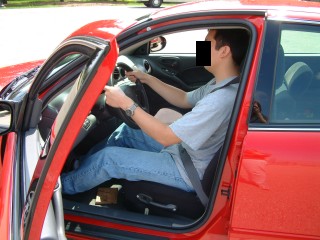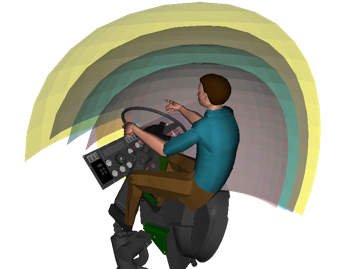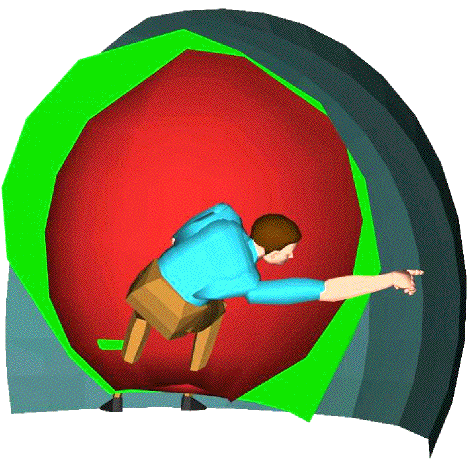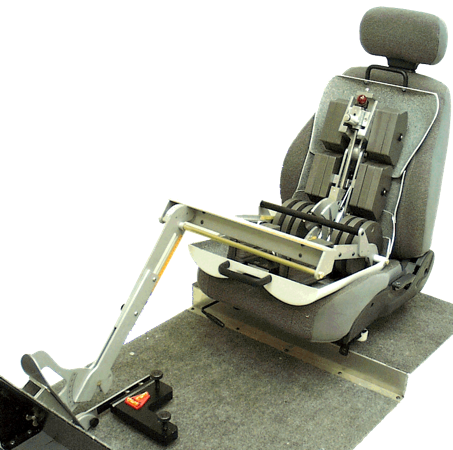>>> Research: Driver and Passenger Ergonomics
Tools for Vehicle Interior Design
Since the late 1970s, UMTRI researchers have studied vehicle occupant posture and position to develop new models for use in vehicle interior design. The overall goal of this research is to provide vehicle designers with tools that will allow them to accurately predict how occupants, particularly drivers, will be positioned in the vehicles. The models address key aspects of occupant posture, including driver-selected seat position, driver eye location, and headroom.
These projects can be termed "functional anthropometry" because they involve measuring and modeling particular task-oriented aspects of human posture. Traditional anthropometry is focused on quantifying human size and shape. Our vehicle accommodation projects rely on traditional anthropometric measures, particularly stature, to quantify the design populations, but the models predict functional outcomes.
- Posture Prediction for Automobile Drivers
- Posture Prediction for Truck Drivers
- Modeling Driver Reach Difficulty
- Automotive Seat and Package Evaluation and Comparison Tools (ASPECT)
- New Industry Standards for Vehicle Interior Design
- Optimizing Vehicle Layout
UMTRI researchers in the Human Factors Division also conduct driver ergonomics research related to lighting and vision and driver interfaces. The work includes laboratory driving-simulator studies and on-road research.
Posture Prediction for Automobile Drivers

An important component of my ergonomics research is the development of posture-prediction models for vehicle occupants. The objective is to predict the postures that people will choose as a function of occupant descriptors (gender, stature, weight...) and vehicle geometry (steering wheel position, seat height, seat back angle...). The primary application of these models is in conjunction with digital human models that provide a three-dimensional CAD representation of the human form (see Research: Digital Human Models). But the models have also been valuable as part of vehicle layout optimization research. The primary model formulation is known as the Cascade Model because it uses a series of cascaded regression functions and inverse kinematics to predict whole-body posture. The key advantage of this approach over alternatives is that it provides optimal accuracy for the most important aspects of posture for vehicle interior design, typically hip and eye locations. Among other applications, the Cascade Model is used as part of the Occupant Packaging Toolkit within the Jack human modeling system.
Posture Prediction for Truck Drivers

I've applied the methods I originally developed for predicting passenger-car postures to heavy trucks. The models are based on data from a laboratory study of truck and bus drivers and were tuned based on data from trucks driven on a test track. These models are also part of the Jack Occupant Packaging Toolkit and are used by a number of companies to develop and assess vehicle interiors. I've used the heavy truck driver posture prediction as part of other research and model development on driver reach and cab layout optimization.
Modeling Driver Reach Difficulty


Reach assessment is one of the most common analyses performed on vehicle operator stations, whether in planes, trains, or automobiles. The Society of Automotive Engineers Recommended Practice J287 presents a statistical model of driver reach capability that has been widely used for both passenger cars and heavy vehicles. However, the conditions under which the underlying data were collected, particularly the occupant restraint conditions, are quite unlike those encountered by drivers today. Along with colleagues from the Human Motion Simulation Lab, I conducted a laboratory study of reach difficulty and capability with truck, bus, and other drivers. I developed a statistical model that predicts the subjective difficulty of reaches to push-button targets up to maximum reach capability. The model has been applied to a variety of reach assessments in commercial and military vehicles. We have also conducted studies of reach kinematics. Among the important conclusions is that maximum seated reach capability is not primarily limited by joint range-of-motion limitations. Rather, balance and tolerance of risk seem to be more important factors. One conclusion of this work is that kinematically generated reach envelopes, which are very common in ergonomic assessments using human models, are unlikely to be accurate.
Automotive Seat and Package Evaluation and Comparison Tools (ASPECT)

The ASPECT program was conducted from 1995 to 1999 by UMTRI and the Biomechanics Design Research Lab at Michigan State University. The primary objective of the work was to develop a new H-point manikin to replace the original SAE H-point machine that was developed in the late 1950s. The ASPECT scope included several laboratory studies of driver and passenger posture, including studies of the effects on posture of vehicle package factors (e.g., steering wheel position) and seat factors (e.g., lumbar support prominence). The ASPECT program was sponsored by twelve auto industry companies, including major automobile manufacturers (GM, Ford, Chrysler, Toyota, BMW, PSA) and seat suppliers (Lear, Johnson Controls, Intier). The major outcomes of ASPECT include the HPM-II, a new H-point manikin that has been adopted in SAE Recommended Practice J4002; the Cascade posture-prediction models; and new design procedures adopted in SAE Recommended Practice J4004.
New Industry Standards for Vehicle Interior Design

The Society of Automotive Engineers (SAE International) maintains, through its standards committees, a series of Recommended Practices that codify tools and methods. My colleagues and I at UMTRI have conducted a series of studies since the late 1980s to replace the previous practices. I have been active on the SAE Human Accommodation and Design Devices and Driver Vision Standards committees as we have substantially revised several of the core occupant packaging practices. New or substantially revised practices based on UMTRI research include:
- J941: Motor Vehicle Drivers' Eye Locations
- J1052: Motor Vehicle Driver and Passenger Head Position
- J4002: H-Point Machine (HPM-II) Specifications and Procedure for H-Point Determination--Auditing Vehicle Seats
- J4003: H-Point Machine (HPM-II)--Procedure for H-Point Determination--Benchmarking Vehicle Seats
- J4004: Positioning the H-Point Design Tool - Seating Reference Point and Seat Track Length
The Seating Accommodation Model developed in this research, and now part of J4004, is the basis for the development of the UMTRI Driver ATD Positioning Procedure, a validated method for positioning crash dummies in postures that are representative of similar-size occupants.
Optimizing Vehicle Layout
The new SAE Recommended Practices for vehicle design developed at UMTRI are based on extensive databases of driver posture and position data and have been developed to be configurable for vehicle geometry and population anthropometry. But they are still essentially univariate, dealing with only one component of the driver posture at a time (e.g., eye location or seat position). The SAE tools do not provide a good framework for optimizing vehicle interiors subject to multiple constraints. For example, is it better to improve driver accommodation by expanding steering wheel adjustment or seat adjustment? Professor Matthew B. Parkinson of the OPEN Design Lab at the Pennsylvania State University and I have developed methods to apply posture-prediction models in the context of an optimization framework. We use the Cascade posture-prediction models with a Monte Carlo simulation approach to conduct accommodation trials with thousands of virtual drivers. The flexible methodology can combine constraints due to safety regulations with comfort and fit criteria.
©2024 Matthew P. Reed and The University of Michigan